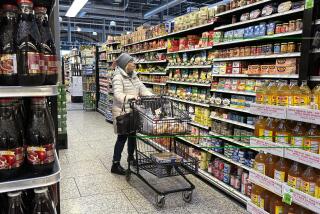U.S. fourth-quarter GDP falls short of expectations
The U.S. economy ended last year on firmer footing with modestly stronger growth. But output fell short of what analysts expected, and signs point to weakness ahead.
The gross domestic product rose at a 2.8% annual rate in the fourth quarter as consumers bought more cars and other goods, the Commerce Department said Friday. That was below the 3% figure many analysts had projected. But it was up from a feeble 1.8% the quarter before.
But the reason for the faster growth wasn’t encouraging: More than half resulted from businesses increasing their stockpiles of products rather than from sales of goods and services, which reflect actual demand.
A big buildup of inventories in one quarter often means manufacturers and other companies will buy fewer supplies in the following months, unless there’s a surprise burst of orders from consumers and others.
But at the moment, there’s little reason to expect a surge in demand from businesses, consumers or government. Friday’s report showed, in fact, that sharp cuts in public spending were a significant drag on the economy.
Moreover, job growth, though improving, is far from robust, and the housing market remains depressed. Political gridlock has doomed further fiscal efforts to spur domestic demand, and Europe’s debt woes and China’s slowdown threaten the global economy.
“Obviously with bloated inventory gains last quarter, [businesses] are going to keep a very tight hold on spending,” said Kathy Bostjancic, an economist at the Conference Board, an employer-supported research group in New York.
“The good news is we avoided a recession,” she said, referring to worries last summer that the economy was headed into a double-dip downturn. But what “you’re left with is a frustratingly slow recovery.”
Friday’s report, along with scaled-back projections issued by the Federal Reserve earlier this week, suggest that the economy, despite a recent pick-up in hiring and manufacturing, will hit many bumps on the long path to full recovery.
The fourth-quarter increase in GDP — the broadest measure of economic activity — was just shy of the 3% that many economists were anticipating. For all of last year, which was marked by problems in Europe, an earthquake in Japan and Washington’s debt-ceiling fiasco, the economy grew 1.7%, well below the post-World War II historical average and very weak considering the depth of the decline during the Great Recession. The sluggish pace doesn’t give employers much incentive to add many workers; rather, they can satisfy their growth needs through productivity gains.
Changes in inventory levels can be difficult to read. In general, companies have been operating with very lean inventories.
“There’s a certain amount of risk [because] if you don’t have the inventory, you could lose orders,” said Bill Thompson, president of Thompson Pump & Manufacturing Co. in Orange, Fla. So far, he added, he has guessed correctly on how much stock to keep on hand.
To Cliff Waldman, economist at Manufacturers Alliance/MAPI, a manufacturing research group, the message from the fourth-quarter inventory buildup was clear: “The fundamental story is that demand remains sluggish — and everything else follows from it.”
Most experts, including those at the Fed, have been projecting that the economy would grow at about a mid-2% range this year. However, Friday’s report raised a question about whether the economy could expand even at that pace.
Ben Herzon, a senior economist at Macroeconomic Advisers, said his forecasting firm recently predicted that the economy would grow at a 1.9% rate in the first quarter of this year and 2.25% for the year as a whole. But the latest report, he said, could lead to a reduction in those projections.
One big unknown going forward is consumer spending, which accounts for about 70% of the American economy. Consumers bought more big-ticket items such as cars in the fourth quarter, but retail sales tailed off. Friday’s data showed that consumers cut into their saving to buy things; the savings rate dropped to 3.7% in the fourth quarter from more than 5% a year earlier.
Business spending for equipment and software, which had been robust since the economic recovery began 2 1/2 years ago, softened toward the end of the year.
U.S. exports, a bright spot in the economy, also could be crimped by a recession in Europe.
Given these obstacles, the Fed this week said it was likely to hold its benchmark short-term interest rate near zero until at least late 2014. Fed officials see the unemployment rate, currently 8.5%, staying uncomfortably high until at least then. The fourth-quarter data may give it another reason to launch another bond-buying effort to stimulate the economy.
In one positive sign, consumer confidence continued to improve in January thanks to more positive news about potential job gains, said economist Richard Curtin, director of the Thomson Reuters/University of Michigan Surveys of Consumers. His surveys showed a substantial increase in confidence over the last five months.
But he said in a release Friday that “the majority of consumers remain deeply skeptical about the prospective strength of the economy.” He said that while twice as many consumers anticipated an improved near-term economic outlook compared with five months ago, “consumers were no more likely to expect their financial situation to improve.”







